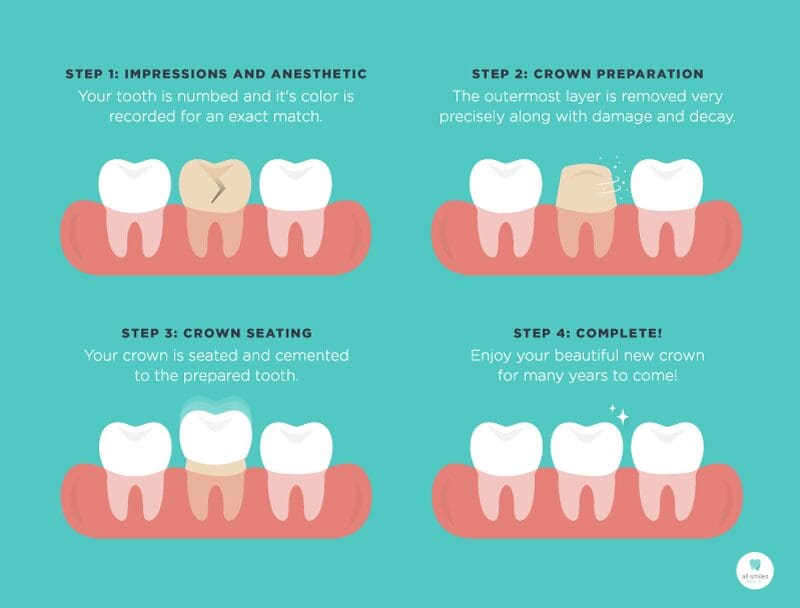A dental crown, or tooth crown, is a common method used by dentists for oral care. Crowns protect the inside of your tooth from further damage and decay.
If you’ve been told that you need a crown procedure, then you may be concerned and have some questions.
Not to worry! We’ve created your complete guide to dental crowns to answer your questions and explain the entire process from start to finish. That way, you can put your mind at ease, knowing exactly what will be done and why!
When Are Dental Crowns Used?
Dental crowns are used for many different reasons, such as:
- To support a tooth that had decay (for example, after a root canal)
- To restore a previously broken tooth
- To protect a weak tooth from any further damage
- To hold a dental bridge in place
- To hide a discolored tooth (more or less a cosmetic modification)
- To cover dental implants
Dental crowns can be used on children’s teeth as well. Your dentist may recommend a crown if:
- The child’s tooth is broken or damaged
- The child’s tooth has extensive decay
In some cases, we’ll recommend a stainless steel crown until a more permanent crown can be put in place. We’ll talk more about temporary crowns in a bit but first:
What Are Dental Crowns?
A dental crown is essentially a tooth-shaped “cap” that is placed over a tooth to restore its shape and size (as well as to improve the appearance).

Types of Dental Crowns
Permanent dental crowns can be made from metal alloys, ceramics, porcelain, porcelain fused to metal, or all-resin.
The one you need depends on the look you’re going for, though there are pros and cons to each type of crown.
Metal Alloys – Metal crowns are great for hidden molars, like the ones in the back of your mouth. They’re not able to match the color of your teeth (as they’ll most likely be gold or platinum), but they’re known to be the best crowns overtime because they rarely chip or break.
Ceramics & Porcelain – If you want your dental crown to look identical to your other teeth, we’d highly recommend a ceramic or a porcelain tooth. These are the most common crowns and work extremely well for those who are allergic to metal.
Porcelain fused to metal – Unlike metal crowns, porcelain fused to metal crowns are able to match the color of your adjacent teeth. However, the porcelain can chip or break off easily and these crowns tend to show near the gum line (especially if your gums begin receding).
All-Resin – All-Resin crowns are the cheapest crowns you can get. However, they wear down over time and are commonly known to chip and fracture.
Steps for Installing a Crown
More often than not, you’ll need to visit the dentist twice to properly make and install your new tooth crown.

Here’s what you can expect when it comes to installing a crown:
First Dental Visit
Your dentist will prepare your tooth by removing the decay and outer portion to determine how the crown will fit.
Next, an impression is made to make an exact model of the tooth you’re getting a crown for. This can be done with a mold or by digitally scanning the tooth.
Depending on how much decay is removed, you may a core buildup to replace the missing tooth structure so that a crown can be placed on top.
Your dentist will place a temporary crown on your tooth as a placeholder for your permanent crown. Keep in mind, your tooth may be sensitive to hot/cold food and drinks with the temporary crown. Also, the adhesive on your temporary is not especially strong so you’ll want to stay away from sticky and chewy foods until you get your permanent crown.

Second Dental Visit:
When your permanent crown is finished, you’ll be called into the dentist a second time to replace the temporary one.
Your dentist will pop out your temporary crown, fill your permanent crown with cement, and place it in your mouth. They’ll put pressure on it for a few minutes to keep it in place. Once your crown is in place, you’re finished!
Caring for Your Teeth After a Crown
So, how do you care for your teeth after getting a dental crown?
We’re glad you asked! It’s important to keep up on your oral hygiene routine — especially after getting a tooth crown. Dental care is incredibly important.
A few things to keep in mind:
- Avoid sticky/chewy food. We recommend staying away from sticky and chewy food for at least 72 hours after getting a crown. Items like gum, candy, and caramel are a no-go. You could pull your dental crown out if you’re not careful!
- Avoid chewing hard food. This includes (but is not limited to) apples, raw vegetables, nuts, and corn on the cob. Eating these foods could break or dislodge your newly placed crown before it’s finished hardening.
- Chew on the “good side” of your mouth. Again, we may ask you to chew on the opposite side of your mouth for up to 72 hours while your dental crown settles into place.
- Brush and floss your teeth daily. The area around your new crown will be sensitive for the first few days, but we ask that you still brush and floss your teeth two times per day (and use mouthwash at least once).
As long as you follow the “72-hour” rule, you should be good to go!
Problems Associated With Dental Crowns
While dental crowns are made to help more than harm, there are a few things that could go wrong.
Please Note: Each person experiences pain/discomfort differently. Regardless of whether your pain is mild or excruciating, we recommend you call your dentist ASAP if you feel any discomfort after receiving a crown.
Some common problems associated with dental crowns are:
- Discomfort and sensitivity. When the anesthesia wears off, you’ll probably feel a bit weird. If you didn’t need a root canal (to remove the entire nerve in your tooth) you may experience sensitivity with hot/cold drinks and food. If you experience pain when you bite down, however, it could mean your crown is too high on your tooth.
- Your crown may chip. Crowns that are made with porcelain or porcelain fused to metal can chip. Composite resin can aid the chip if it’s small enough, otherwise, you’ll need a new crown.
- Loose crown / crown falls off. The cement can wash away from under the crown. This is problematic for more reasons than one — the crown will be loose and, in severe cases, can fall off, giving bacteria a chance to get into the crown. Regardless, you should call your dentist immediately if your crown is loose or if it falls off.
Conclusion
Dental health is important for your well-being. A big part of dental health is properly caring for your teeth, which may mean installing a dental crown. Or perhaps you’re just interested in cosmetic dentistry and want to improve the look of your smile.
Either way, we hope this guide taught you everything you needed to know about dental crowns and put your mind at ease if you were nervous for your appointment!
If you’re just in the phase where you’re considering a crown procedure and happen to live in the Bismarck, North Dakota area, we would love to help you!
Click here to see our location and hours or to contact us for more information.

